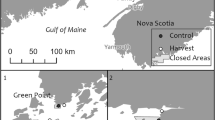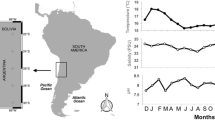Abstract
Ascophyllum nodosum (rockweed) landings in the Atlantic Maritime provinces of Canada totalled 36,500 wet tonnes in 2009. Due to the relative slow growth, stochastic recruitment, and the importance of habitat protection, strict harvest regulations are in place in the region to maintain the integrity of this resource. Special harvesting rakes have been designed to cut the plants and not to dislodge the clumps and their holdfasts from the substratum. However, for various reasons, close to 6% of the biomass harvested annually contains holdfast material. This proportion is closely monitored by the province as it is assumed to represent clump mortality. However, due to the complex structure of A. nodosum clumps, this relationship with mortality is not simple. A study was carried out to evaluate the real impact of this detachment on the A. nodosum population of southern New Brunswick in 2004. The structure of harvested A. nodosum clumps with associated holdfast material was analyzed and compared to non-harvested clumps from the same harvest area. Results showed that when a rake strips a clump, it only detaches 17.4% of the holdfast surface, leaving 36.8% of the plant biomass and 80.3% of the shoot density intact. An analysis of storm-cast material from the same study area showed a similar effect in the clump structure, although the incidence of holdfast in the detached biomass could be as high as 30%. Due to the high biomass detached each year by coastal storms in New Brunswick, their impact on the A. nodosum resource is 21 times higher than the annual harvest.







Similar content being viewed by others
References
CAFSAC (1992) Rockweed in southern New Brunswick. CAFSAC Advisory Document 92/3
Cousens R (1984) Estimation of annual production by the intertidal brown alga Ascophyllum nodosum (L.) Le Jolis. Bot Mar 27:217–227
Dudgeon S, Petraitis P (2005) First year demography of the foundation species, Ascophyllum nodosum, and its community implications. Oikos 109:405–415
Kiirikki M, Ruuskanen A (1996) How does Fucus vesiculosus survive ice scraping? Bot Mar 39:133–139
Lazo L, Chapman ARO (1996) Effects of harvesting on Ascophyllum nodosum (L.) Le Jol. (Fucales, Phaeophyta): a demographic approach. J Appl Phycol 8:87–103
McCook LJ, Chapman ARO (1991) Community succession following massive ice-scour on an exposed rocky shore: effects of Fucus canopy algae and of mussels during late succession. J Exp Mar Biol Ecol 154:137–169
Rangeley RW (1994) Habitat selection in juvenile Pollock, Pollachious virens: behavioural responses to changing habitat availability. Ph.D. Dissertation, McGill University
Rangeley RW, Davis J (2000) Gulf of Maine rockweed: management in the face of scientific uncertainty. Huntsman Marine Science Centre occasional report no. 00/1:93
Rangeley RW, Kramer DL (1998) Density-dependent antipredator tactics and habitat selection in juvenile Pollock. Ecology 79:943–952
Sharp GJ (1986) Ascophyllum nodosum and its harvesting in Eastern Canada. In: Case studies of seven commercial seaweed resources. FAO Technical Report, vol. 281, pp 3–46
Sharp GJ, Bodiguel C (2002) Introducing integrated management, ecosystem and precautionary approaches in seaweed management: the Ascophyllum nodosum (rockweed) harvest in New Brunswick Canada and implications for industry. In: Chapman ARO (ed) Proceedings of the XVII International Seaweed Symposium. Oxford University Press, Oxford, pp 107–114
Sokal RR, Rohlf FJ (1995) Biometry: the principles and practice of statistics in biological research, 3rd edn. W. H. Freeman and Co., New York. 887 pp. ISBN: 0-7167-2411-1
Ugarte R, Sharp GJ (2001) A new approach to seaweed management in eastern Canada: the case of Ascophyllum nodosum. Cah Biol Mar 42:63–70
Ugarte R, Sharp GJ, Moore B (2006) Changes in the brown seaweed Ascophyllum nodosum (L.) Le Jol. plant morphology and biomass produced by cutter rake harvests in southern New Brunswick, Canada. J Appl Phycol 18:351–359
Ugarte R, Critchley A, Serdynska AR, Deveau JP (2009) Changes in composition of rockweed (Ascophyllum nodosum) beds due to possible recent increase in sea temperature in Eastern Canada. J Appl Phycol 21:591–598
Ugarte R, Craigie JS, Critchley AT (2010) Fucoid flora of the rocky intertidal of the Canadian Maritimes: implications for the future with rapid climate change. In: Israel A, Einav R, Seckbach J (eds) Seaweeds and their roles in globally changing environments. Springer, Heidelberg
Vadas LV, Wright A, Miller SL (1990) Recruitment of Ascophyllum nodosum: wave action as source of mortality. Mar Ecol Prog Ser 61:263–272
Viejo RS, Aberg P, Cervin G, Lindegarth M (1999) The interactive effects of adult canopy, germling density and grazing on germling survival of the rockweed Ascophyllum nodosum. Mar Ecol Prog Ser 187:113–120
Acknowledgements
I would like to express my appreciation to Glyn Sharp for the review and useful comments made on the manuscript. Dr. Marcelo Bobadilla provided valuable statistical support. Joshua Sharp and Bruce Moore provided valuable support during data collection.
Author information
Authors and Affiliations
Corresponding author
Rights and permissions
About this article
Cite this article
Ugarte, R.A. An evaluation of the mortality of the brown seaweed Ascophyllum nodosum (L.) Le Jol. produced by cutter rake harvests in southern New Brunswick, Canada. J Appl Phycol 23, 401–407 (2011). https://doi.org/10.1007/s10811-010-9574-y
Received:
Revised:
Accepted:
Published:
Issue Date:
DOI: https://doi.org/10.1007/s10811-010-9574-y




